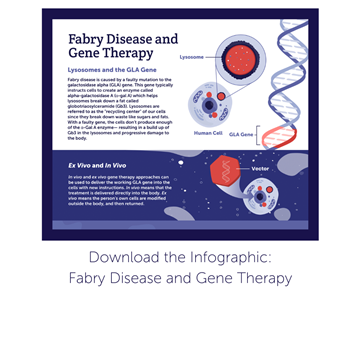Fabry disease is a rare genetic disorder caused by the lack of an enzyme due to a faulty gene. Without enough of this key enzyme, a part inside cells called lysosomes are unable to do their job of breaking down waste. This results in a buildup that causes a variety of symptoms, including pain, fatigue, and kidney and/or heart failure, and can be life-threatening. Gene therapy aims to offer a one-time treatment to slow or ideally stop progression of the disease by introducing a working GLA gene to provide instructions to the cells to produce the deficient enzyme.
Fabry Disease and Gene Therapy
Fabry disease has a classic form (Type 1) that starts in childhood, and a form with late onset in adulthood (Type 2). Both types are caused by a mutated galactosidase alpha (GLA) gene and have varying levels of severity. The GLA gene provides the instructions for cells to produce the alpha-galactosidase-A (α-Gal A) enzyme, which helps the lysosomes then break down waste like fats and sugars because lysosomes are a part of cells that function as the “recycling center.”
 One gene therapy approach to deliver a working copy of the GLA gene into cells is in vivo. This involves an injection of the gene therapy into specific parts of the body so that new genetic instructions can be delivered directly to the cells within the body. The new instructions to the cells would be to produce α-Gal-A enzyme that will restore lysosomal function to break down the buildup of a type of fat called globotriaosylceramide (Gb3). This is done using a vector, which is like an envelope with a message, that delivers the working gene to the target cells. Vectors are often derived from viruses, since they are very good at getting into cells. However, all the viral genes are removed, and the vector is modified to only deliver therapeutic genes into cells. Gene therapy approaches currently being studied either deliver the vectors to reach the cells of the liver or target the heart along with other affected organs such as the kidneys and liver.
One gene therapy approach to deliver a working copy of the GLA gene into cells is in vivo. This involves an injection of the gene therapy into specific parts of the body so that new genetic instructions can be delivered directly to the cells within the body. The new instructions to the cells would be to produce α-Gal-A enzyme that will restore lysosomal function to break down the buildup of a type of fat called globotriaosylceramide (Gb3). This is done using a vector, which is like an envelope with a message, that delivers the working gene to the target cells. Vectors are often derived from viruses, since they are very good at getting into cells. However, all the viral genes are removed, and the vector is modified to only deliver therapeutic genes into cells. Gene therapy approaches currently being studied either deliver the vectors to reach the cells of the liver or target the heart along with other affected organs such as the kidneys and liver.
There is also an ex vivo approach being studied for Fabry disease, meaning outside the body. This requires the use of stem cells, which are versatile cells that can develop into many different cell types depending on what the body needs. For this approach, there are specific stem cells removed from the person’s body, which are then modified by introducing a vector (carrying the working GLA gene) to these cells. The modified cells are then returned to the body to deliver the new instructions of the working GLA gene to create more of the α-Gal-A enzyme.
Treatment Pipeline
There are gene therapy approaches for Fabry disease that are currently in preclinical studies and clinical trials. Research and development of these therapies is being done by companies including 4DMT Therapeutics, Amicus, AvroBio, Sangamo and Uniqure.
To stay up to date on active and recruiting clinical trials in the U.S. or globally, visit the ASGCT Clinical Trials Finder and search for Fabry disease in the "diagnosis" filter.
Existing Treatments
There is currently no cure for Fabry disease. Enzyme replacement therapy is a treatment that works well to reduce Gb3 lipids in many tissues of the body, but does not effectively reduce Gb3 in the heart’s muscle cells. This results in heart complications. Enzyme replacement therapy requires lifelong infusions, which can be required as often as every two weeks. There is also an oral treatment available, but it only works for those with certain types of GLA gene mutations.
Availability
There are ongoing gene therapy clinical trials for Fabry disease, while other research is still in preclinical studies, which are the earliest stages of research. This is a necessary phase of research that establishes the safety and effectiveness of a treatment in animal or cell-based models before proceeding with human clinical trial investigation. Eligibility for a trial is based on strict inclusion and exclusion criteria, which is an important way for researchers to understand if the gene therapy is working properly and to ensure participant safety. For example, some trials for Fabry disease require the individual to be 18 years or older, male, and have not received enzyme replacement therapy within the last 10 years. However, this criteria can vary and some trials allow a participant to continue enzyme replacement therapy. It is important to consult your treating physician before considering clinical trial participation.
Get Involved
Getting involved with patient advocacy organizations is a great way to connect with other families and people affected by Fabry disease. These organizations help provide useful resources or guidance and often advocate and raise funds for research. The diseases may be rare, but you and your family are not alone.